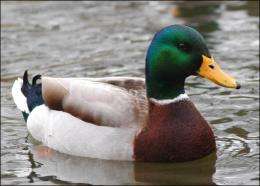April 15, 2011 report
Bright bills in mallards helps duck semen fight bacteria

(PhysOrg.com) -- The male Mallard duck (Anas platyrhynchos) is known for its colorful neck and a bill that ranges in color from dull green to bright yellow, depending on the amount of carotenoid pigment it contains. Females favor the males with the most colorful bills, and now new research in Norway has shown that these males produce semen with better antibacterial properties.
Dr Melissah Rowe of the University of Oslo collected semen samples from 11 captive mallard ducks with bills of varying degrees of brightness to test them for antibacterial properties. She reasoned that since human sperm can be damaged by bacteria, this might be an issue in ducks as well, and protections for sperm might have evolved.
Collecting semen samples from mallard ducks is not a simple matter, since the penis is corkscrew shaped and withdrawn into the body until the male is aroused. The researchers injected lymphatic fluid into the penis and massaged the cloaca area to persuade the penis to emerge and ejaculate semen for collection.
Tests of the samples revealed that they inhibited the growth of bacteria, but this effect was more pronounced in the males with the most colorful bills, at least for one type of bacteria, Escherichia coli. In selecting males with the most colorful bills, females are therefore selecting semen that is less likely to carry E. coli bacteria. The semen was also able to kill Staphylococcus aureus bacteria, but there was no association with bill color. The experiments are the first to demonstrate antibacterial properties of semen in birds.
It has previously been shown that sperm of the most colorful males is of higher quality and speed. Dr Rowe said that in preferring males with more colorful bills females were gaining some fitness benefit, or the trait would not have evolved. Sexually selected traits have been shown by other researchers to be associated with sperm quality, overall health, and with parenting ability.
In the paper, published in Biology Letters, Dr Rowe cautioned that the effect of E. coli on duck sperm is not yet known, but it is known to have a detrimental effect on human sperm in its quality and viability. It is also not known whether an E. coli infection can be sexually transmitted in ducks. The next stage of the research is to identify the semen component that gives it its antibacterial properties.
More information: Sexual ornamentation reflects antibacterial activity of ejaculates in mallards, Biol. Lett. Published online before print April 13, 2011, doi:10.1098/rsbl.2011.0276
© 2010 PhysOrg.com



















